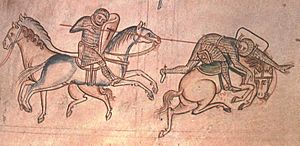Battle of Monmouth (1233) facts for kids
Quick facts for kids Battle of Monmouth |
|||||||
|---|---|---|---|---|---|---|---|
| Part of the rebellion of Richard Marshal against Henry III | |||||||
 The ruined Great Tower of Monmouth Castle |
|||||||
|
|||||||
| Belligerents | |||||||
| Commanders and leaders | |||||||
| Baldwin III | Richard Marshal | ||||||
| Strength | |||||||
| ? | ? | ||||||
| Casualties and losses | |||||||
| Heavy | |||||||
The Battle of Monmouth took place on 25 November 1233, the feast day of St Catherine, between forces loyal to Henry III, King of England, and those of Richard Marshal, Earl of Pembroke and Lord Marshal of England, who had formed an alliance with the Welsh prince Llywelyn ap Iorwerth and his supporter Owain ap Gruffydd, a grandson of Rhys of Deheubarth.
Contents
Background
Richard Marshal, the second son of the more famous William Marshal, 1st Earl of Pembroke, was a leader of the barons opposed to the growth of King Henry's powers. He was an adversary of the king's foreign allies at court, notably the Poitevins Peter de Rivaux and Peter des Roches. Marshal refused to attend Henry's court at Gloucester in August 1233, and Henry declared him a traitor. Marshal retired to his castle at Striguil (Chepstow), while the king and his army moved west to Abergavenny. In response, Marshal joined with Owain to seize the castles at Cardiff and Newport before attacking Abergavenny and Grosmont. The king then retreated to Gloucester.
Battle

According to the chronicler Roger of Wendover in his Flores Historiarum (Flowers of History), Marshal and his knights then came to Monmouth to reconnoitre the town before besieging it. However, they were seen coming towards the castle walls by Baldwin III, Count of Guînes. He was a nobleman of Flanders who, with his mixed force of Flemings and Poitevins, had been entrusted by King Henry with defending the town. The local lord, John of Monmouth, was absent from the battle. Baldwin wrongly thought that Marshal had only a few followers with him, and rode out with his forces to pursue him, but Marshal turned the tables.
Aftermath
After the battle, which Baldwin survived, John of Monmouth returned to take control of the town. Marshal travelled to Ireland to rally his supporters there. He agreed a truce with Henry early in 1234, but died of wounds sustained in the Battle of the Curragh shortly afterwards.
Location
The Glamorgan-Gwent Archaeological Trust refer to the battle as having taken place at Castle Field, to the west of the River Monnow, land today known as Vauxhall Fields. Other sources suggest, on the basis of an order placed in 1234 for thirty oaks from the Forest of Dean to repair the Church of St Thomas the Martyr, located to the south-west of the town, that the adjoining Monnow Bridge would have been the one mentioned in the chronicle of the fighting and which was partly destroyed at that time.

